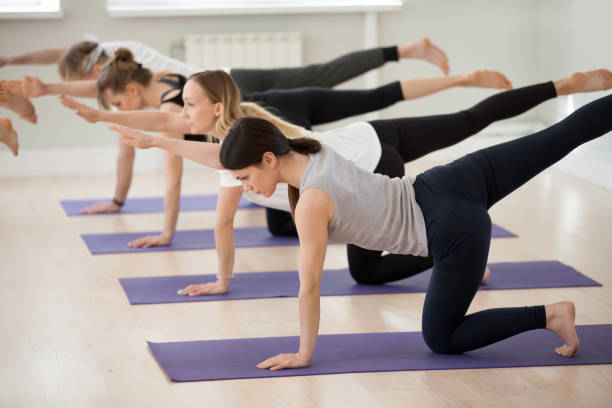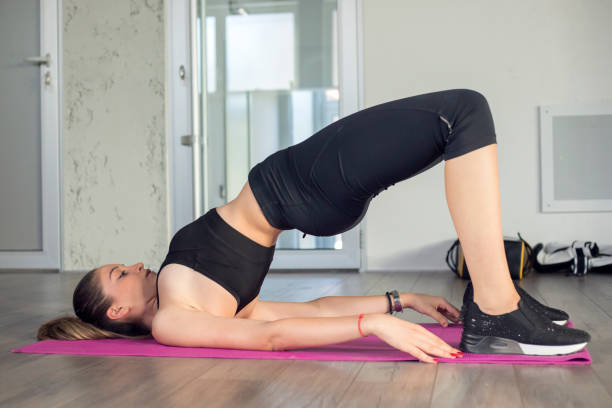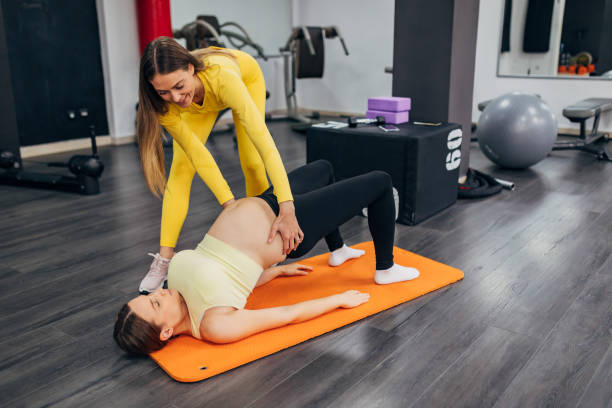Tips for Fitness Fanatics: Exercise Swaps to Effectively Relieve Lower Back Pain
As a gym and fitness enthusiast, you know how important it is to take care of your body. However, even with the best intentions, sometimes injuries or problems arise.
One common issue that many fitness enthusiasts face is lower back pain.
Lower back pain can be caused by various factors, and the key ones have been outlined in this article.
If you battle with lower back pain, this is your deserved guide. You will gather that there are certain exercise swaps you can make to help alleviate lower back pain and even prevent it from recurring.
But let’s learn about where lower back pain stems from.

Causes of Lower Back Pain among Fitness Enthusiasts
Below are the leading causes of lower back pain among fitness fanatics:
Poor Exercise Technique
Poor exercise technique is a major cause of lower back pain among fitness enthusiasts.
Many people tend to overlook the importance of proper form when performing exercises, which can result in significant strain on the lower back muscles.
This is particularly true of exercises that involve lifting heavy weights, such as deadlifts, squats, and overhead presses.
To avoid lower back pain due to poor exercise technique, always perform exercises with the correct form. This can be achieved by seeking the guidance of a qualified fitness instructor or personal trainer. They can help you to identify and correct any weaknesses or imbalances that may be contributing to your lower back pain.
Muscle Imbalances
Muscle imbalances occur when one muscle group becomes stronger or more dominant than its opposing muscle group. For example, if your quadriceps are much stronger than your hamstrings, your pelvis might tilt forward, which can lead to lower back pain.
To avoid lower back pain due to muscle imbalances, engage in exercises that help to strengthen the weaker muscle groups. For the best results, adopt a well-rounded exercise program that focuses on both strength training and flexibility exercises.
Overuse Injuries
Overuse injuries occur when a person engages in the same type of exercise repeatedly without giving their body enough time to rest and recover. This can result in muscle strains, sprains, or even herniated discs in the lower back.
To avoid overuse injuries, vary your exercise routine and give your body enough time to rest and recover between workouts. Even better, incorporate different types of exercises into your workout routine and take time off to allow your body to heal after intense workouts.

Exercise Swaps to Address Lower Back Pain
When dealing with lower back pain, incorporate specific muscle-targeting exercises to strengthen the core, hips, and surrounding muscles.
Here are three thoughtful exercise swaps to ease your lower back pain:
Replace Crunches with Planks

Crunches are a staple exercise for toning your abs. But if you are experiencing lower back pain, you may want to consider swapping out your crunches for planks.
Planks are a great alternative to crunches because they are a static exercise – meaning you hold a position rather than perform a repetitive movement. This puts less strain on your lower back while still engaging your core muscles.
Here are some tips to help you swap out crunches for planks:
1. Start with a Modified Plank
If you are new to planks, start with a modified version.
Begin in a push-up position and then lower your body down onto your forearms. Keep your body in a straight line from your head to your heels. Hold this position for as long as you can, aiming for at least 30 seconds.
2. Focus on Form
When performing a plank, it is essential to maintain proper form.
Keep your shoulders and hips aligned and engage your core muscles by pulling your belly button towards your spine. Avoid letting your hips sag or lift too high.
3. Increase Exercise Duration Gradually
As you get stronger, gradually increase the duration of your plank hold.
Aim for 60 seconds, then 90 seconds, and so on. Remember to take breaks as needed and focus on maintaining proper form.
4. Add Variations
There are many different variations of the plank that you can try to keep things interesting and challenge your muscles in different ways. For example, you can try side planks, plank jacks, or even add in some mountain climbers.
5. Don’t Forget to Stretch
After your plank workout, be sure to stretch out your core and lower back muscles.
This can help alleviate any tension or soreness and prevent injury.
By swapping out your traditional crunches for planks, you can alleviate lower back pain and still achieve a strong, toned core.
Remember to start with a modified plank, focus on proper form, gradually increase duration, add variations, and always stretch after your workout. With consistency and dedication, you’ll be able to master the plank and reduce your lower back pain in no time.
Replace Seated Leg Lifts with the Bird Dog Exercise

Seated Leg Lifts are a popular exercise for targeting the lower body, particularly the glutes and hamstrings. However, this exercise requires sitting upright on a bench or chair with your legs extended in front of you, which can put pressure on the lower back. For individuals with lower back pain, this pressure can be uncomfortable and potentially exacerbate the issue.
The Bird Dog Exercise, on the other hand, is a low-impact exercise that targets the core muscles, including the lower back. To perform this exercise, start on all fours with your hands directly under your shoulders and your knees directly under your hips. From this position, extend your right arm out in front of you while simultaneously extending your left leg behind you. Hold this position for a few seconds, then return to all fours and repeat on the opposite side.
The Bird Dog Exercise strengthens the muscles supporting the spine, including the erector spinae and multifidus muscles. These muscles play a crucial role in maintaining proper posture and alignment, which can alleviate lower back pain. Additionally, the Bird Dog Exercise engages the core muscles, including the rectus abdominis and obliques, which can improve overall core stability and balance.
To swap Seated Leg Lifts for the Bird Dog Exercise in your workout routine, start by incorporating the Bird Dog Exercise as a warm-up or cool-down exercise. Begin with a few sets of 10-12 repetitions on each side, focusing on maintaining proper form and engaging the core muscles. As you become more comfortable with the exercise, you can increase the number of repetitions or add resistance bands to make the exercise more challenging.
While the Bird Dog Exercise can be a great alternative to Seated Leg Lifts for individuals with lower back pain, it is not a substitute for medical treatment or physical therapy. So, if you experience chronic or severe lower back pain, consult with a healthcare professional before beginning any new exercise routine.
Replace Sit-Ups with Pelvic Tilts

Pelvic tilts are a great exercise for targeting the lower back muscles and strengthening the core. They involve lying on your back with your knees bent and feet flat on the floor. From there, you simply tilt your pelvis upward, creating a small arch in your lower back. Hold for a few seconds, then release and repeat.
But what if you’re used to doing sit-ups to strengthen your core?
While sit-ups can be effective, they also put a lot of strain on the lower back. If you’re experiencing pain, swap out this exercise for something gentler like pelvic tilts.
To get started with pelvic tilts, lie on your back with your knees bent and feet flat on the floor. Take a deep breath and exhale as you tilt your pelvis upward, pressing your lower back into the ground. Hold for a few seconds, then release. Repeat this movement for several reps, focusing on engaging your core and lower back muscles.
As you become more comfortable with pelvic tilts, you can start to add variations to the exercise. For example, you can try lifting one leg off the ground while performing the tilt, or you can hold a small weight in your hands to add resistance. Just be sure to listen to your body and stop if you experience any pain or discomfort.
In addition to incorporating pelvic tilts into your workout routine, there are other steps you can take to alleviate lower back pain. Make sure to stretch before and after your workouts, and avoid sitting for long periods. If you must sit for extended periods, take frequent breaks to stand up and stretch.
It’s also vital to maintain good posture throughout the day. This means sitting up straight, keeping your shoulders back, and engaging your core muscles to support your lower back. And if you work at a desk, acquire an ergonomically designed chair and adjust your computer monitor to eye level to avoid straining your neck.

Over to You…
In addition to these exercise swaps, there are a few other things you can do to help alleviate lower back pain. Make sure you’re stretching before and after your workouts, and consider incorporating yoga or Pilates into your routine.
Additionally, be mindful of your posture throughout the day and try to avoid sitting for extended periods.
Lower back pain can be frustrating and debilitating, but with the right exercise swaps and lifestyle changes, you can alleviate the issue and prevent it from recurring.
Remember to always listen to your body and speak with a healthcare professional if you’re experiencing chronic pain or discomfort.
Looking to build muscle and endurance without breaking the bank? Don’t look any further.
Subscribe to Kloud Iron’s 28-day fitness program and begin your journey toward optimal mental health and physical fitness.
To learn more about Kloud Iron Fitness Hub’s offers, contact us today or message/follow us on Facebook and Instagram. We are also available on YouTube.


1 Comment
conta aberta na binance
3 months agoThanks for sharing. I read many of your blog posts, cool, your blog is very good.